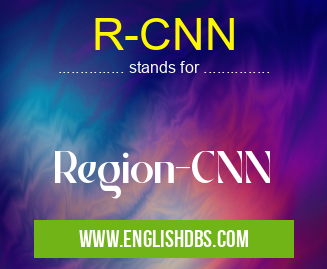What does R-CNN mean in ENGINEERING
R-CNN (Region-based Convolutional Neural Network) is a pioneering object detection algorithm developed by Ross Girshick et al. in 2014. It combines the power of region proposals with deep convolutional neural networks (CNNs) to achieve state-of-the-art results in object detection tasks.

R-CNN meaning in Engineering in Academic & Science
R-CNN mostly used in an acronym Engineering in Category Academic & Science that means Region-CNN
Shorthand: R-CNN,
Full Form: Region-CNN
For more information of "Region-CNN", see the section below.
Key Concept
- Region Proposals: R-CNN first generates region proposals, which are potential bounding boxes for objects in the image. These proposals are obtained using a selective search algorithm that divides the image into small regions.
- CNN Feature Extraction: Each region proposal is then fed into a CNN to extract deep features. These features capture the essential characteristics of the objects within the proposals.
- Classification and Bounding Box Regression: The extracted features are used to train a classifier to predict the class (e.g., person, car, dog) of each region proposal. Additionally, a bounding box regressor is used to refine the proposed bounding boxes to improve their accuracy.
Advantages
- High Accuracy: R-CNN's combination of region proposals and CNNs enables it to achieve excellent detection accuracy.
- Flexibility: R-CNN can be trained on various datasets and can detect a wide range of object categories.
- Robustness: The use of region proposals helps reduce the computational cost and improves the robustness of the algorithm.
Limitations
- Computational Cost: Generating region proposals can be time-consuming, making R-CNN slower than some other object detectors.
- Overlapping Proposals: The selective search algorithm may generate overlapping region proposals, leading to redundant computations and potential false positives.
Essential Questions and Answers on Region-CNN in "SCIENCE»ENGINEERING"
What is R-CNN?
R-CNN (Region-based Convolutional Neural Network) is a computer vision technique used for object detection. It combines region proposals with convolutional neural networks (CNNs) to accurately locate and classify objects in images.
How does R-CNN work?
R-CNN generates region proposals using a selective search algorithm and then applies a CNN to extract features from each proposal. These features are then used to classify objects and refine their bounding boxes.
What are the advantages of R-CNN?
R-CNN offers several advantages:
- High accuracy in object detection and classification
- Ability to handle complex images with multiple objects
- Robustness to background noise and occlusion
What are the limitations of R-CNN?
R-CNN has certain limitations:
- Slow processing time due to the need for multiple CNN evaluations
- Sensitive to region proposals, which can affect accuracy
- Limited ability to detect small or heavily occluded objects
What are the applications of R-CNN?
R-CNN is widely used in various applications, including:
- Object detection and recognition
- Image classification
- Scene understanding
- Medical image analysis
What are the different variants of R-CNN?
There are several variants of R-CNN, including:
- Fast R-CNN: Improves processing time by sharing CNN computations across proposals
- Faster R-CNN: Further speeds up processing using a region proposal network (RPN)
- Mask R-CNN: Generates object masks in addition to bounding boxes
Final Words: R-CNN is a foundational object detection algorithm that played a significant role in advancing the field of computer vision. Its ability to combine region proposals with deep learning paved the way for the development of more sophisticated and efficient object detectors. While R-CNN has some limitations, its accuracy and flexibility make it a valuable tool for a wide range of object detection tasks.
